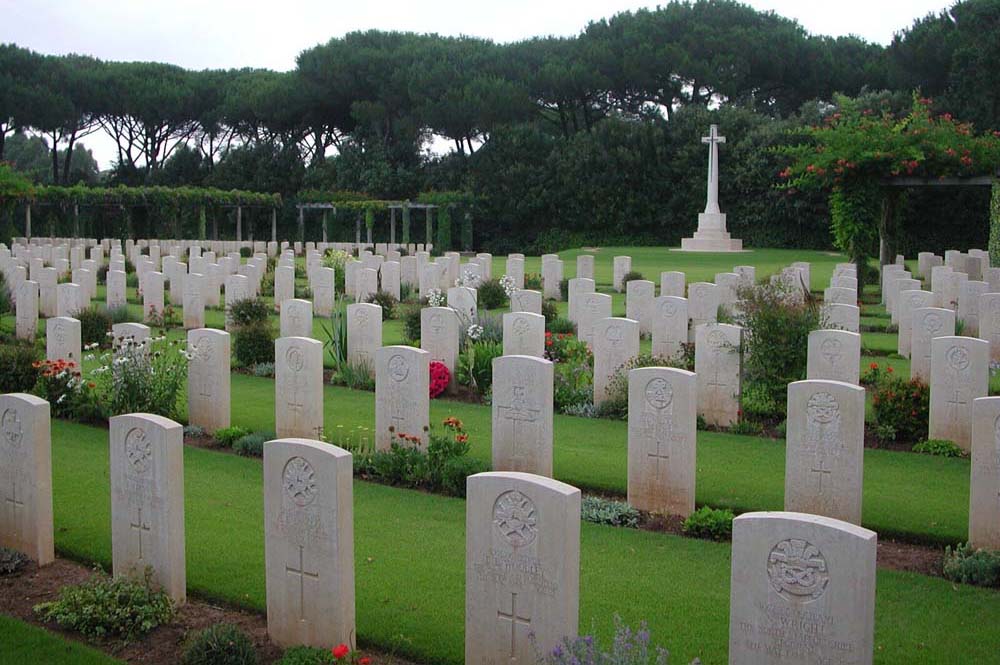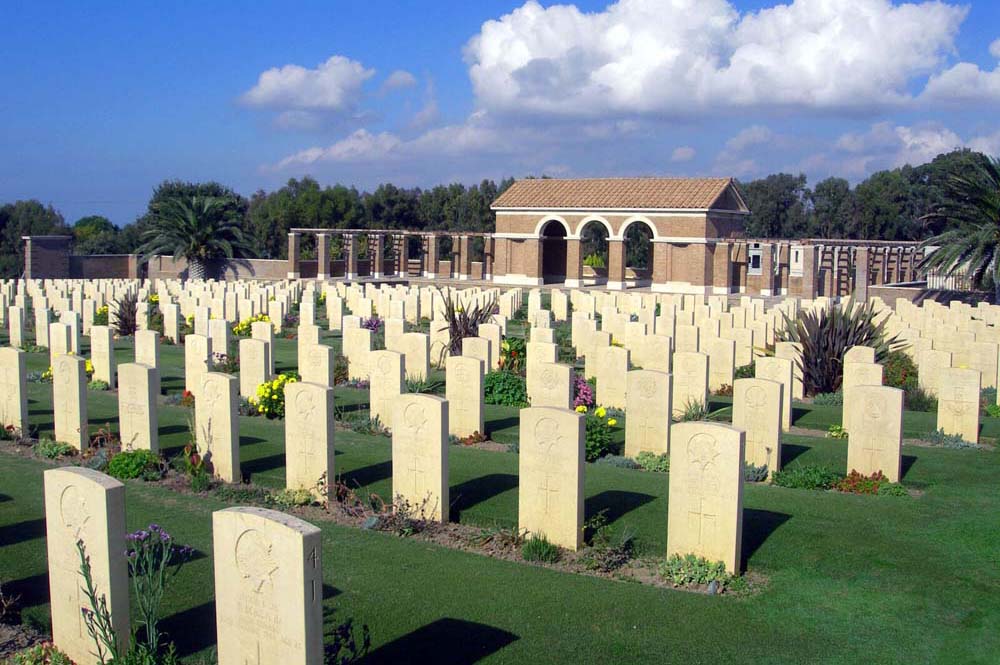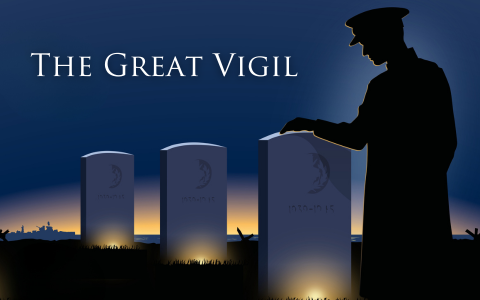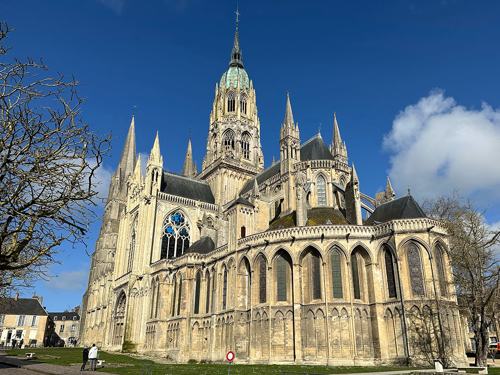13 May 2024
Legacy of Liberation: The Battle of Monte Cassino and the Allies’ Road to Rome
The Legacy of Liberation continues at Commonwealth War Graves as we examine The Battle of Monte Cassino in WW2: the Italian Campaign’s decisive moment.
The WW2 Battle of Monte Cassino
A war cemetery in the shadow of a mountain

Take a stroll up the craggy winding paths of Monte Cassino to the monastery-topped summit, and a wide vista of Lazio countryside opens up before you.
Amidst the rolling hills, plunging valleys and mountain peaks, the roads to Rome wind themselves towards the Italian. With the sun beating down and a light breeze, it becomes a spot of incredible beauty but also peace.
At the base of the mountain lies a spot of quiet tranquillity; a reminder of when this part of the world was rent asunder by blood, bullets, and battle.
Cassino War Cemetery holds some 4,300 Commonwealth burials of the Second World War. The majority of these casualties were killed in the first five months of 1944, during some of the darkest days of the Italian Campaign.
Within the cemetery lies Cassino War Memorial, commemorating over 4,000 more Commonwealth soldiers with no known grave.
The fighting around Monte Cassino was amongst the toughest faced by Allied troops in any Western theatre of the Second World War. Italy, far from being the quick win favoured by Allied high command, turned into a bloody 18-month campaign.
For many the WWII Monte Cassino Battle is the definitive moment of the Italian Campaign, but the Commonwealth War Graves Commission cemeteries and memorials in Italy show us the cost of victory in Italy.
Eric Fletcher Waters
 Image: Eric Fletcher Waters
Image: Eric Fletcher Waters
Second Lieutenant Eric Fletcher Waters was born in County Durham in 1914. He and his wife Mary had two sons: John, who later became a taxi driver, and Roger, who became one of the founding members of the rock group Pink Floyd.
A devout Christian, Eric was a pacifist and was originally excused from military service as a conscientious objector – he instead served as an ambulance driver in Cambridge in the early years of the war.
However, after joining the British Communist Party his ardent anti-fascist beliefs drove him to reconsider military service.
He enlisted as a Second Lieutenant with the 8th Battalion Royal Fusiliers (City of London Regiment) and went on to see active service in Italy.
Eric was killed on 18 February 1944 during the fighting at Anzio. His body was never recovered, and so he is commemorated on the Cassino Memorial. His son Roger was only five months old at the time of his father’s death.
Roger wrote a song, "When the Tigers Broke Free", about his father’s death at Anzio.
Commonwealth War Grave Cemeteries & Memorials in Italy
Commonwealth War Graves’ Italian sites have a fascinating part of the country’s legacy of liberation. They tell of contested river crossings, hilltop assaults, and daring amphibious assaults.
Of course, they also tell of the cost paid by Allied armies in pursuit of the liberation of Italy.
Louis de Soissons
 Image: Louis De Soissons
Image: Louis De Soissons
No discussion of CWGC’s Italian war cemeteries and memorials is completed without mentioning Louis de Soissons.
Born in Montreal Canada in 1890, Louis de Soissons became one of the CWGC’s most influential architects of the post-Second World War Era.
Even as early as July 1944, while fighting was still raging in the north of Italy, Louis was personally surveying sites for potential new war cemeteries. His work was greatly influenced by the architecture of Ancient Rome and Greece, incorporating classical forms and techniques into his designs.
Louis's connection to Commonwealth War Graves was deeply personal. He was more than just an architect for us. He was a grieving parent too.
Louis’s son, Philip, was lost at sea when his ship, HMS Fiji was sunk off the coast of Crete in May 1941. Philip was just 17 when he died.
Louis de Soissons went on to design 40 war cemeteries and memorials in Greece and Italy. These are some of the most beautiful Commonwealth War Graves Commission sites in the world.

Sangro River War Cemetery and the Sangro River Cremation Memorial
Most of those buried at Sangro River War Cemetery died in the fighting on the Adriatic coast, but the cemetery also contains the graves of a number of prisoners of war who died while trying to escape to the Allied lines. Today it contains over 2,600 Commonwealth war graves.
Within the cemetery is the Sangro River Cremation Memorial, one of three memorials erected in Italy to officers and men of the Indian forces whose remains were cremated in accordance with their faith - the other two cremation memorials are in Forli Indian Army War Cemetery and Rimini Gurkha War Cemetery.
The memorial at Sangro River commemorates more than 500 servicemen.

Minturno War Cemetery
Situated near the Gustav Line, the town of Minturno was liberated soon after Allied forces crossed the Garigliano River on 17 January 1944. The site for the cemetery was chosen at that time, but the Allies then lost some ground and the site came under German small-arms fire.
Minturno War Cemetery could not be used again until May 1944, when the Allies launched their final advance on Monte Cassino and Rome and the US 85th and 88th Divisions were in this sector. The burials are mainly those of the heavy casualties incurred in crossing the Garigliano in January 1944.
Minturno War Cemetery contains over 2,000 Commonwealth war graves.

Moro River Canadian War Cemetery
Fighting up the Adriatic coast, the 1st Canadian Division crossed the Moro River on 6 December 1943 against stiff opposition. They went on to take the town of Ortona on 28 December, after a week of bitter street fighting with German Fallschirmjäger (paratroopers).
While the fighting continued to the west at Cassino, there was virtually no movement east of the Apennines until after the fall of Rome.
The site of Moro River Canadian War Cemetery was chosen by the Canadian Corps in January 1944, and it contains the graves of those who died during the fighting in the surrounding areas. Over 1,600 Commonwealth servicemen are buried here, and the majority served with Canadian forces.
Monte Cassino in world war 2
Monte Cassino is a rocky hill. It lies some 130 kilometres southeast of Rome.
The history of Cassino stretches back to Ancient Rome. The ruins of the town of Casinum sit close by.
A grand medieval Benedictine abbey used to sit atop the mountain, one of the largest and most beautiful in Europe. An abbey still sits atop Monte Cassino but it’s a post-war recreation of the original for reasons that will become clear soon.
What was the battle of Monte Cassino?

Image: Sikh troops pick their way through the rubble at Monte Cassino (© IWM)
The World War 2 Battle of Monte Cassino was fought between the Allies and Nazi Germany between 11 January – 18 May 1944.
Two Allied formations were deployed to Italy: the American Fifth Army and the British Eighth Army. Both had served in the deserts of North Africa and during the invasion of Sicily. They epitomised the multinational nature of the Allied war effort.
General Harold Alexander, in command of Commonwealth forces in Italy, led men from across the globe: Canadians, New Zealanders, Indians and South Africans, men from across the United Kingdom, and Gurkhas from Nepal. They fought alongside Polish troops, Free French divisions and Italian Royalist units. There was even a Brazilian Expeditionary force deployed to Italy in September 1944.
Following the Allied landings on the heel of the Italian mainland at Taranto and Salerno, the Germans slowly withdrew north, destroying bridges, railways and roads. In late December 1943, the painstaking and hard-fought Allied advance halted some 70 miles south of Rome, near the town of Cassino.
Background to Cassino: The Italian Campaign

Image: British soldiers come ashore on Sicily. Thoughts of a similarly quick victory on Mainland Italy were quickly erased (© IWM)
Fascist Italy and its leader Benito Mussolini declared war on Britain and France on 10 June 1940.
Over the next three years, Italian and Commonwealth forces clashed on land, sea, and air, notably in North Africa.
After years of fighting in the sands of North Africa, the Axis forces stationed there were conclusively defeated in early 1943.
With the Axis out of Africa, the Allies turned to other theatres to press their advantage home. After much discussion, Italy was chosen as a priority target.
On 10 July 1943, a vast armada of almost 2,600 ships landed over 180,000 Commonwealth and American troops on Sicily.
Fifteen days later the Italian leader, Benito Mussolini, was arrested, and a pro-Allied government took power.
Most Italian troops on Sicily offered little resistance from then on and in mid-August the island was secured.
Though the Allies had incurred fewer casualties than anticipated, the experience of fighting across Sicily was a foretaste of what was to come.
Operation Avenger aka the first Allied attack at Cassino
Breaking through the Gustav Line would not be easy. Combating the weather as much as the Axis forces, the first attempts to break through at Cassino in January were costly failures. To subdue the German forces, Allied commanders ordered a ferocious aerial bombardment to eliminate their defences.
On 16 February, the Benedictine monastery which stood on Monte Cassino was largely destroyed, and in March bombers targeted the town of Cassino. Rather than reducing resistance, this eventually enabled German troops to occupy stronger positions amid the debris.
Attacking through the scrub and boulders of Monastery Hill, the 4th Indian Division suffered heavy losses under relentless machine gun and mortar fire, while the 28th New Zealand (Māori) Battalion suffered more than 60% casualties fighting for control of Cassino’s railway station.
Charlie Hapeta
 Image: Charlie Hapeta (courtesy of the Hapeta Family)
Image: Charlie Hapeta (courtesy of the Hapeta Family)
Charlie Hapeta was born to Mr & Mrs Charlie Hapeta of Okaihau, Auckland. He was the husband of Ngareta Hapeta of Horeke and together the couple had four children. Charlie enjoyed boxing and worked as a labourer before enlisting. He left New Zealand in July 1943 and joined the 28th (Maori) Battalion, then serving in Italy.
On the night of 17-18 February 1944, Commonwealth forces launched ‘Operation Avenger’, the second major attempt to capture Monte Casino. The 28th Māori were at the forefront of the assault, crossing the Rapido River and pushed on towards the Cassino railway station.
After a night and morning of heavy fighting the Maoris captured the station but, lacking support, they were forced to retreat during the afternoon, in the face of counterattacks by German tanks.
During the fighting, Charlie was killed along with nineteen of his unit. He was 24 years old. Today he is buried alongside his comrades in Cassino War Cemetery.
Anzio

Image: British soldiers dig in at Anzio (© IWM)
With the advance stalling at Cassino, Allied planners searched for other solutions to break the Gustav Line.
An amphibious assault was planned under the name Operation Shingle. Landing at Anzio would put Allied soldiers behind the Gustav Line, opening the way to Rome.
With the Allied offensive facing the formidable obstacle of Monte Cassino, an amphibious assault to the north at Anzio, codenamed Operation Shingle, was designed to open the way to Rome.
In the early hours of 22 January, on calm seas under clear skies, Allied forces landed almost without opposition. The British 1st Division, supported by Commandos, landed to the north, with the US 3rd Infantry Division, along with US Rangers, to the south.
By midday, all the initial assault objectives had been secured, but Allied commanders chose to consolidate their position rather than advance. Meanwhile, eight German divisions rushed to close off Anzio, surrounding the Allied forces.
A long-awaited attempt to break out from the beachhead began on 30 January. By then, German defences were well-prepared, and concentrated mortar, artillery and machine-gun fire held back the assault, while exhausted Allied soldiers clung on in hastily constructed forward positions, subjected to frequent counterattacks.
Constant tension and deteriorating weather conditions took their toll on the battle-weary soldiers, now fighting an unexpected defensive war in trenches and dugouts.
Nowhere was beyond the range of German artillery and the Luftwaffe, which continuously harassed Allied shipping and soldiers alike, particularly at night.
With the exposed landing zone offering little protection, movement above ground was dangerous. These conditions endured until 23–24 May, when Allied forces finally broke out from the bridgehead.

Beach Head War Cemetery, Anzio
During Allied operations in the Anzio bridgehead, this site was a centre for medical care. British No. 2 Casualty Clearing Station (CCS) along with field surgical units and field ambulances operated here and began the cemetery now known as Beach Head.
After the war, battlefield burials and graves from the surrounding country were brought here.
Beach Head War Cemetery, Anzio now the final resting place of more than 2,300 Commonwealth servicemen, the names of nearly 300 of whom remain unknown.
Close to 1,500 of the soldiers, sailors and airmen buried here died during the defence of the Anzio bridgehead between February and May 1944, and more than 500 were killed during the breakout in late May.
Maurice Albert Wyndham Rogers VC
 Image: Sergeant Maurice Albert Wyndham Rogers
Image: Sergeant Maurice Albert Wyndham Rogers
Sergeant Maurice Albert Wyndham Rogers was born in 1919 in Bristol, England. He joined the army in 1934 at the early age of 14 as a drummer boy, and at 18 became part of the regular army. He served with the 2nd Battalion Wiltshire Regiment and helped the battalion’s athletic team win the Northern Command Athletic Championship in 1937.
Maurice saw action in France in 1940 and was evacuated from Dunkirk. During a short period of leave in London in 1941, Maurice married Lena Stone in Bethnal Green. In March 1942 his battalion left England and took part in the assault on Madagascar before going on to serve in India, Iran, Syria, Palestine, and Egypt before landing in Sicily in July 1943. In March 1944 the battalion was sent to reinforce the Allied landings at Anzio.
During the night of 2-3 June 1944 Maurice and his battalion attacked high ground held by the German forces, sustaining heavy casualties under intense fire. Rogers continued to advance alone, penetrating 30 yards inside the enemy's defences, drawing their fire, and throwing them into confusion. Inspired by his example, the platoon began the assault.
Serjeant Rogers was blown off his feet by a grenade and wounded in the leg but continued to run on towards an enemy machine-gun post, where he was shot and killed at point-blank range. His platoon went on to achieve their objective.
Maurice was posthumously awarded the Victoria Cross for most prestigious gallantry. He is buried in Beach Head War Cemetery.

Anzio War Cemetery
This site was chosen as a final resting place for Commonwealth servicemen shortly after the landings at Anzio on 22 January 1944, and nearly all of those buried here fell over the subsequent six weeks.
Anzio War Cemetery is now the final resting place of more than 1,050 Commonwealth soldiers, sailors and airmen, of whom 19 remain unidentified.
John & Thomas Cairncross
 Image: John & Thomas Cairncross
Image: John & Thomas Cairncross
John and Thomas Cairncross were twins from Newburgh, Fife, Scotland. They had joined the army in October 1943 – on their 19th birthday – and enlisted initially with the Black Watch before transferring to the 1st Battalion (London Scottish) Gordon Highlanders.
They were sent to Italy and took part in Operation Shingle, the Allied landings at Anzio, in early 1944. Their unit was sent ashore in February after the initial landings as reinforcements. They took over positions about 10 miles inland near the village of Carroceto.
On 4 February, one of the twins was killed early in the day, and the other swore vengeance against the enemy for his brother’s death and threw himself into combat. He was killed later that same day.
Today both brothers are buried in Anzio War Cemetery.
Operation Diadem & Victory at Cassino

Image: British and Polish flags flutter triumphantly from the summit of Monte Cassino (© IWM)
Monte Cassino took four months to crack.
The beautiful abbey of Monte Cassino had been reduced to rubble. Cassino town was also now a ruin.
The burden of extracting the Wehrmacht from Monte Cassino’s summit fell to men, not machines. Water, rations, and ammunition all had to be carried up the winding mountain paths, as men dodged machine-gun and mortar fire from above.
On 11 May 1944, the Allies launched Operation Diadem in another attempt to break the Cassino deadlock.
At 23:00, elements of the British 4th Infantry and 8th Indian Divisions, with support from the 1st Canadian Armoured Brigade, launched Diadem. Facing determined defence at the Garigliano and Rapido rivers, the British and Indian troops crossed the rivers and broke into the Wehrmacht defences at the heart of the Liri Valley.
This took the pressure off the Anzio beachhead. Free French soldiers pushed into the Mountains while the US troops surged out of the Anzio Beachhead.
At Cassino itself, New Zealand, Indian, British, and Free French soldiers reinforced the Polish II Corps as it pushed up to root out heavily dug-in German paratroopers hiding amongst the ruins.
On 17 May, the final attack began. With the Polish Corps in the vanguard, under heavy artillery and mortar fire, the fighting was fierce, often descending into hand-to-hand combat.
With their supply lines under threat in the Liri Valley, and Allied troops forging up the mountain in overwhelming force, the German forces atop Cassino pulled back on May 18.
In the early hours of the 18th, the British 78th Division linked up in the Liri Valley with Polish II Corps. Soon after, a patrol from the Polish 12t Podolian Cavalry Regiment made it to the peak and proudly raised a Polish flag over the ruins.
The road to Rome was open.
Losses - Battle of Monte Cassino WW2 casualties
The Allies lost over 50,000 men killed and wounded at Cassino, and more than 2,000 of the Commonwealth servicemen laid to rest at Cassino War Cemetery died during the final efforts to take Monte Cassino in May.
The capture of Monte Cassino opened the route to Rome, but German resistance would continue further north along the Gothic Line. Many of those who would fall in the battles to come are commemorated on the Cassino Memorial.
You can read more stories about the real people behind the Battle of Monte Cassino on Evermore.

Cassino War Cemetery
The site for Cassino War Cemetery was originally selected in January 1944, but the development of the battle during the first five months of that year made it impossible to use it until after the Germans had withdrawn from Cassino.
The majority of the 4,300 or so servicemen buried in the war cemetery died in the battles during these months.
Nearly 300 of those buried at Cassino War Cemetery are unidentified.

Cassino War Memorial
Cassino War Memorial lies within Cassino War Cemetery.
It commemorates by name over 4,000 Commonwealth officers and enlisted soldiers who were killed during the Monte Cassino Battle in WW2, but have no known grave.
The memorial was designed by Louis de Soissons, taking inspiration from classical architecture, including a stunning mosaiced floor next to the reflecting pool.
The Road to Rome & The D-Day Dodgers
Rome became the first major European capital to be liberated on 5 June 1944.
Events in Normandy would overshadow this moment but there is no doubting the skill, determination, bravery and cost in lives it took from the Allies to reach Rome.
The Allies would face many more months of gruelling warfare in the mountains to the north. Over the following weeks, Commonwealth forces pursued the retreating Axis units as they withdrew behind successive lines of fortifications.
By early August, the Allies were closing up to the next major German defensive position, the Gothic Line.
The day after newspapers had carried headlines about the liberation of Rome, Allied forces landed on the coast of Normandy in northern France. ‘D-Day’, marking the start of Operation Overlord, overshadowed the Italian Campaign, and commanders, units and resources were withdrawn from Italy to take part in the Normandy landings.
Even though many of those fighting in Italy were veterans of several years of fighting and had experienced some of the most intense and brutal combat in Western Europe, their efforts were often underappreciated, leading to the nickname "The D-Day Dodgers".
A popular song epitomised the bitter humour of veterans of Italy:

On 6 April 1945, the Allies began their final offensive in Italy, Operation Grapeshot.
On 22 April, the Allies began crossing the River Po, and on 25 April Italian partisans began uprisings in the cities of northern Italy, supported by Allied air supplies and special forces.
While Commonwealth forces advanced north-east towards Venice and Trieste, the U.S. Fifth Army pushed foward to Genoa, Milan, and Turin.
On 28 April 1945, Benito Mussolini was executed by partisans, having been captured three days before while trying to flee to Switzerland. Soon afterwards, German commanders formally surrendered. Hostilities in Italy came to an end on 2 May 1945.
Discover the Legacy of Liberation with Commonwealth War Graves
The Legacy of Liberation marks the 80th anniversary of Monte Cassino and several pivotal moments during the Second World War.
From Kohima and Imphal to the D-Day Landings, the Legacy of Liberation remembers these remarkable events.
Join us to mark these historic moments. Visit The Legacy of Liberation today to learn more.

Lighting their Legacy
Across the UK, May & June
Discover our national programme of events and inspire the next generation.

The Great Vigil
Normandy, 5 June
Join the culmination of our D-Day events as we illuminate every CWGC grave in Normandy.

DISCOVER OUR 80TH ANNIVERSARY WW2 EVENTS
We're holding a number of events across the UK and in Normandy in the build up to the 80th anniversary of D-Day. Find out more about what we're planning and discover how you can get involved.
Find out more
